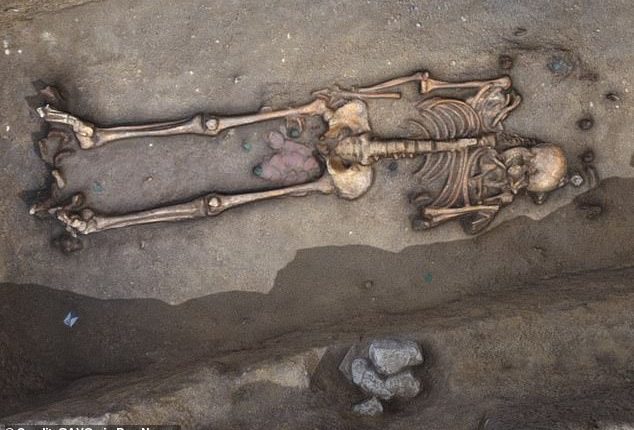Ancient curses invoking the wrath of the gods have been discovered in a series of mysterious graves beneath a historic hospital.
Excavations at the former Porte Madeleine hospital in Orléans, France, have revealed dozens of male burials dating back to the Roman era.
And in several graves, curse tablets known as defixio have been found. They call upon Roman gods to punish various wrongdoers, identified by name.
Project managers Caroline Millereux and Julien Courtois said 22 had been found so far, spread across 11 burials, boosting the number of defixio found in France by 50 per cent.
So far, only two of the tablets have been deciphered.
One, in the extinct Gallic language, asks Mars – the Roman god of war – for the ‘bewitchment’ of multiple people and their accomplices ‘who accomplished the unfortunate and unjust feat’.
Ms Millereux and Mr Courtois said: ‘They are very thin sheets of lead with an inscription intended to harm one or more people – the ones we found are either rolled or folded.
‘The tablets were often written by individuals seeking justice or to exert spells on enemies or rivals, or even to protect personal objects.

Excavations at the former Porte Madeleine hospital in Orléans, France , have revealed dozens of male burials dating back to the Roman era. In several burials, such as the one above, curse tablets known as defixio have been found. Pictured: The remains of the tablet can be seen between the skeleton’s legs
The tablets call upon Roman gods to punish various wrongdoers, identified by name, Above: A curse tablet after restoration and unfolding. It is also seen under an RTI (Reflectance Transformation Imaging) scan, with the text highlighted. An RTI involves multiple images being manipulated under varying light conditions to draw out information that is difficult to see
‘The objective was to raise supernatural aid in order to bind someone under the control of the person who laid the curse.
‘The authors of these tablets were usually anonymous individuals seeking magical or divine help, but in some cases their names are mentioned.
‘It is common for the authors to be private individuals – often commoners, sometimes slaves or traders – and for the inscription to be addressed to deities or spirits.’
They added: ‘Defixio were made for a very long period of time – the first ones are dated to the sixth century BC.
‘However, discovering 22 tablets on the same archaeological site, increasing the corpus known in France by 50 per cent, is remarkable!’
Another, in Latin, calls upon Mercury – the Roman god of financial gain and commerce – to denounce two thieves, Sgaurillus and Gnossius, and make them return their plunder.
Those laying the curses may have written the tablets themselves, or they might have hired a professional to do it for them, if they could not write.
Despite the tablets being found in graves, it’s thought that the deceased were merely ‘intercessors’, relaying the curse for somebody else.

One of the burials seen with a ceramic jug. The burials themselves date from the end of the first century AD, up to the middle of the third century AD

So far, 76 ancient graves have been excavated, all belonging to men, and all lined up in a row with no cremations

One of the rolled up curse tablets. Only two of the ancient documents have been deciphered so far
The archaeologists said: ‘The curses were always placed beneath the ground – to reach chthonian gods and goddesses.
‘They were buried in graves or tombs, or thrown into wells or pools, or sequestered in underground sanctuaries, or nailed to the walls of temples.’
The former hospital at the site was built in 1675, closing only in 2015.
But the burials themselves date from the end of the first century AD, up to the middle of the third century AD.
At the time, France was the Roman province of Gaul, and Orléans was called Cenabum.
So far, 76 ancient graves have been excavated, all belonging to men, and all lined up in a row with no cremations.
The deceased were between the ages of 20 and 50.
It suggests this was no ordinary burial ground.

Workers at the site of the excavation, at the former Porte Madeleine hospital in Orléans, France

A scan of an unopened curse tablet made with X-ray tomography

A worker excavates burial F2199, which was found with a curse tablet between its legs

One of the rolled up curse tablets. The objects have been found in several graves at the site of a former hospital

The burial pits before the skeletons were excavated

Scientist Andrew King prepares a curse tablet for X-ray tomography

Workers excavate one of the skeletons at the former Porte Madeleine hospital in Orléans, France
Reached via email, the archaeologists wrote: ‘We really do have a lot of tablets, and in an atypical funerary space, with only active men.
‘There is undoubtedly a reason for this, and we hope to be able to answer this question.
‘To this purpose, we will try to decipher the other tablets, which also appear to be inscribed.
‘And we’re going to continue to study the human bones that have been found – perhaps we’ll discover the reason for their deaths, or their jobs or status.’
They continued: ‘We imagine today that their tomb was chosen for symbolic reasons, due to their profession or status in Roman society in Orléans.
‘But it could be just a story of opportunity.
‘We also imagine that the reason for the presence of tablets, and in such large numbers, is not just because the site is well-preserved.
‘It’s a reflection of the mentality of the people of Orléans – that they believed in this magic, that of the defixio.’










